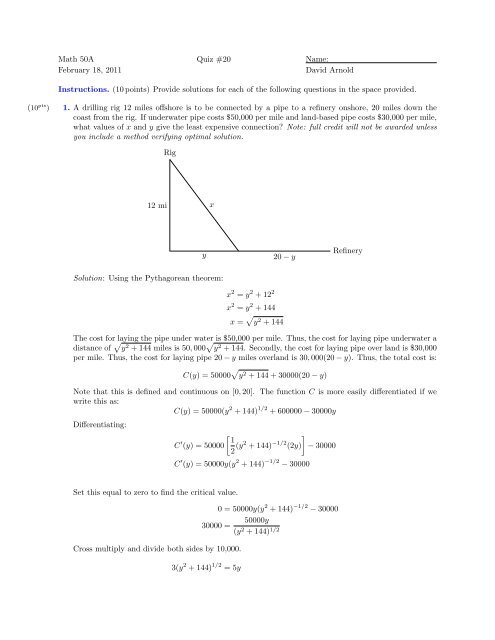Math 50A February 18, 2011 Quiz #20 Name: David Arnold ...
Math 50A February 18, 2011 Quiz #20 Name: David Arnold ...
Math 50A February 18, 2011 Quiz #20 Name: David Arnold ...
Create successful ePaper yourself
Turn your PDF publications into a flip-book with our unique Google optimized e-Paper software.
<strong>Math</strong> <strong>50A</strong><br />
<strong>February</strong> <strong>18</strong>, <strong>2011</strong><br />
<strong>Quiz</strong> <strong>#20</strong><br />
<strong>Name</strong>:<br />
<strong>David</strong> <strong>Arnold</strong><br />
Instructions. (10 points) Provide solutions for each of the following questions in the space provided.<br />
(10 pts ) 1. A drilling rig 12 miles offshore is to be connected by a pipe to a refinery onshore, 20 miles down the<br />
coast from the rig. If underwater pipe costs $50,000 per mile and land-based pipe costs $30,000 per mile,<br />
what values of x and y give the least expensive connection? Note: full credit will not be awarded unless<br />
you include a method verifying optimal solution.<br />
Rig<br />
12 mi<br />
x<br />
y<br />
20 − y<br />
Refinery<br />
Solution: Using the Pythagorean theorem:<br />
x 2 = y 2 + 12 2<br />
x 2 = y 2 + 144<br />
x = √ y 2 + 144<br />
The cost for laying the pipe under water is $50,000 per mile. Thus, the cost for laying pipe underwater a<br />
distance of √ y 2 + 144 miles is 50, 000 √ y 2 + 144. Secondly, the cost for laying pipe over land is $30,000<br />
per mile. Thus, the cost for laying pipe 20 − y miles overland is 30, 000(20 − y). Thus, the total cost is:<br />
C(y) = 50000 √ y 2 + 144 + 30000(20 − y)<br />
Note that this is defined and continuous on [0, 20]. The function C is more easily differentiated if we<br />
write this as:<br />
C(y) = 50000(y 2 + 144) 1/2 + 600000 − 30000y<br />
Differentiating:<br />
[ ]<br />
1<br />
C ′ (y) = 50000<br />
2 (y2 + 144) −1/2 (2y) − 30000<br />
C ′ (y) = 50000y(y 2 + 144) −1/2 − 30000<br />
Set this equal to zero to find the critical value.<br />
Cross multiply and divide both sides by 10,000.<br />
0 = 50000y(y 2 + 144) −1/2 − 30000<br />
50000y<br />
30000 =<br />
(y 2 + 144) 1/2<br />
3(y 2 + 144) 1/2 = 5y
<strong>Math</strong> <strong>50A</strong>/<strong>Quiz</strong> <strong>#20</strong> – Page 2 of 2 – <strong>Name</strong>:<br />
Square both sides:<br />
Solve for y:<br />
9(y 2 + 144) = 25y 2<br />
9y 2 + 1296 = 25y 2<br />
1296 = 16y 2<br />
y 2 = 81<br />
y = 9<br />
Now we move to the Extreme Value Theorem, evaluating C at both endpoints and at the critical value.<br />
Next:<br />
Finally:<br />
Arranging results in a table:<br />
C(0) = 50000 √ 0 2 + 144 + 30000(20 − 0)<br />
= 50000(12) + 600000<br />
= 1200000<br />
C(9) = 50000 √ 9 2 + 144 + 30000(20 − 9)<br />
= 50000 √ 225 + 330000<br />
= 50000(15) + 330000<br />
= 750000 + 330000<br />
= 1080000<br />
C(20) = 50000 √ 20 2 + 144 + 30000(20 − 20)<br />
= 50000 √ 544<br />
= 50000(4 √ 34)<br />
= 200000 √ 34<br />
y C(y)<br />
0 1,200,000<br />
9 1,080,000<br />
20 200, 000 √ 34<br />
Thus, the minimum cost occurs when y = 9. We can find x by substituting y = 9 into:<br />
x 2 = √ y 2 + 144<br />
x 2 = √ 9 2 + 144<br />
x 2 = √ 225<br />
x = 15<br />
Hence, set y = 9 miles down the shore, which forces an underwater length of x = 15 miles. This will<br />
minimize the cost of construction.

















